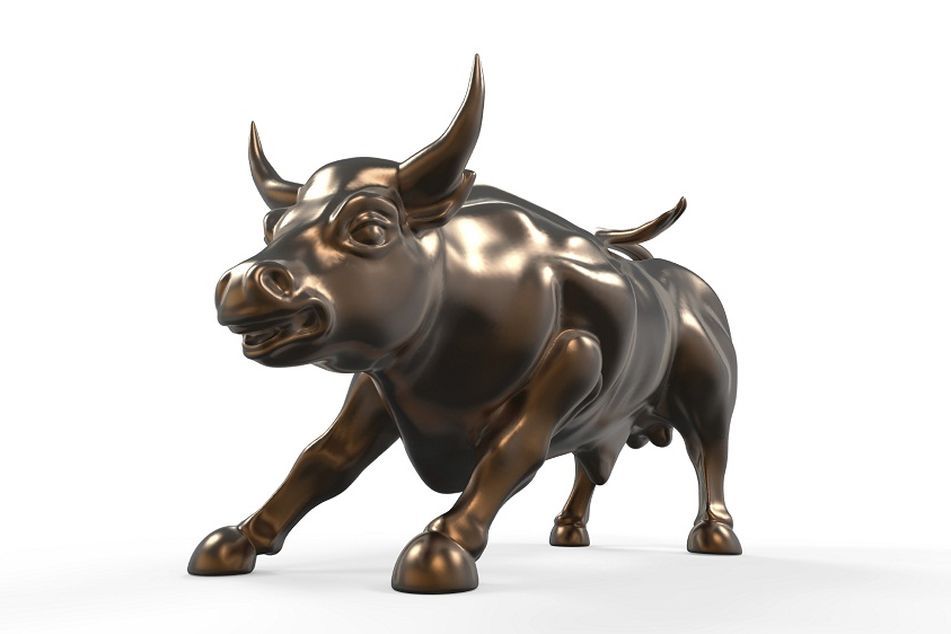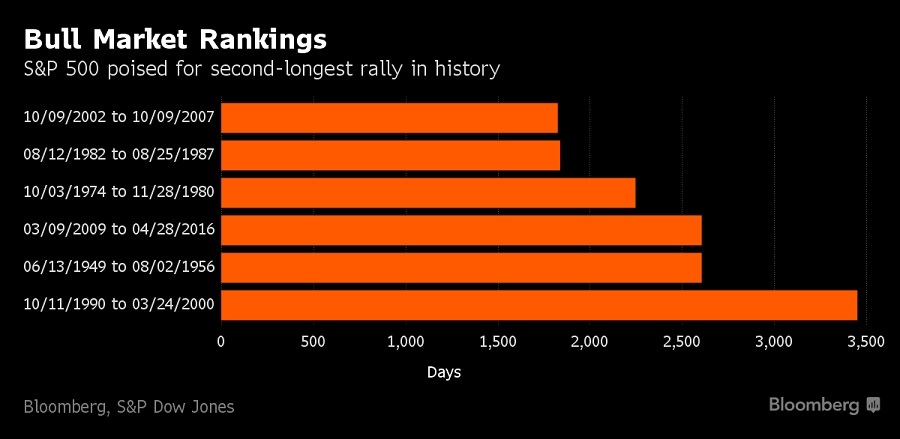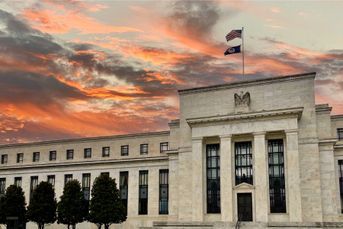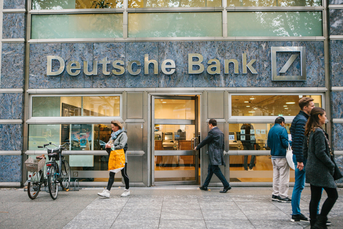The U.S. is in the midst of a historic bull market

Most-hated S&P 500 rally poised to become second-longest
A bull market that has been derided as fake, doomed and history’s most-hated just earned a new title: the second-longest ever.
Dodging and weaving through three 10% drops in the last 19 months while avoiding the 20% decline that denotes a bear market, the advance that began seven weeks after Barack Obama’s first inauguration in January 2009 has now lasted 2,607 days. That matches a rally from 1949 to 1956 which straddled the presidencies of Harry Truman and Dwight D. Eisenhower. Only the dot-com bubble of the 1990s lasted longer at 3,452 days.
Yet again, the rally is showing signs of fatigue: for the first time its rolling 12-month return is negative, and companies in the Standard & Poor’s 500 Index are reporting their worst profits in six years. At the same time, economists are steadily downgrading their growth forecasts, the international outlook is much worse and investors are pulling money from equities at an unprecedented rate.
Such threats are nothing new, and speculating that anything could stop the seven-year-old advance has always been a fool’s game. The Federal Reserve and other central banks have shown time and again that they stand ready to inject more cash into the financial system at the first sign of market turbulence.
“I don’t remember another post-war bull market that was this fearful, chronically and persistently,” said Jim Paulsen, the Minneapolis-based chief investment strategist at Wells Capital Management Inc., which oversees $337 billion. Investors are “forever prepared for the end of the world, but reluctantly being dragged back into to equities.”
The New Yorker writer John Brooks’ chronicle of the 1950s bull market is called “The Seven Fat Years,” a title few people would apply to America since the financial crisis. In truth, the signature characteristic of the Obama bull market has been its ability to soar above an economy going nowhere, returning 3.7% a quarter on average since March 2009, compared with a 0.9% gain in gross domestic product. That gap is the widest ever.
Bulls and bears divide on how that happened. To optimists, the 210% rally in stocks is justified by a commensurate expansion in earnings, achieved by managers focused on efficiency and cost cuts by the experience of the financial crisis. Pessimists see a market that rose only in proportion to the trillions of dollars in liquidity injected by the Fed.
Even without any growth this year, profits in the S&P 500 will come to about $118 a share, almost double the $62 a share recorded in 2009. While falling now, profit margins, which measure how much of every dollar hits the bottom line, are still hovering near all-time highs reached in 2014.
Another plank in the bull case says nothing happening in the stock market since 2009 represents a radical break from the past. The S&P 500 may be up 18% annually since 2009, but viewed from 10, 15 or 20 years ago, gains are roughly in line with the average of 7% since World War II.
On the other side are arguments tied to sales growth and the Federal Reserve. Revenue per share in the S&P 500 is likely to total $1,126 in 2016, about one-third the increase in profits versus seven years ago. The lower slope of increase has left the index’s price-to-sales ratio at 1.9, near a 15-year high.
Besides aggressive cost cutting, profit growth has been driven by some of the lowest financing costs ever, courtesy of the Fed. Record-low interest rates sent the cost of servicing debt to the lowest in data going back to 1990, at 3.7% of sales in the last 12 months. The decline from 7.4% in 2007 represented $310 billion in savings.
“We need a positive trajectory to economy and higher earnings to sustain the bull,” said Howard Ward, who oversees $42.7 billion as chief investment officer of growth equities at Gamco Investors Inc. “The bears argue the economy is slowing and is not poised to accelerate. Low rates, they say — after such a prolonged period of easy money — signal a liquidity trap and have fueled financial speculation.”
Stocks are stuck in their longest period of stasis since the rally began, going 11 months without posting a 52-week high. Fallow periods lasting longer than 12 months are poison to chart analysts, who view them as an indication of waning momentum over the long term. In the past, deep losses have not only signaled the end of bull markets but also foretold recessions.
A study by Leuthold Weeden Capital Management LLC showed that since World War II, the S&P 500’s rolling 12-month returns adjusted for inflation have averaged minus 9% at the economy’s peak. The measure reached minus 9.6% in February.
RESILIENT BULL MARKET
At the same time, the bull market has been nothing if not resilient, posting a series of rebounds from selloffs starting in October 2014 that rank with the sharpest in history. During the first quarter, the S&P 500 reversed an 11% slump for the biggest turnaround since 1933. In the previous two routs that ended in September last year and a year earlier, the index jumped about 10% in a month.
One force driving the recent snap-back is pessimism that’s dogged the bull market since its birth, according to Bill Stone, Philadelphia-based chief investment strategist at PNC Wealth Management, which oversees $130 billion.
Americans have been sellers of equities since 2007, slashing stock holdings by $2 trillion, data compiled by Fundstrat Global Advisors LLC show. While the pace of the liquidation is unprecedented since 1956, that represents a huge pool of potential demand, according to Tom Lee, the firm’s managing partner. Investors’ exodus during the decade that started in 1979, the year when BusinessWeek featured a cover story titled “The Death of Equities,” preceded a 400% rally in the 1990s.
“Historically, if you’re looking for a model of what kills bull markets, it’s a combination of over-valuation and over-ownership,” Mr. Stone said. “You can argue with me on the valuation side, but we never got the last person who puts their money in. Because it’s a mistrusted bull market, you continue to get people to finally capitulate.”
The list of investor worries has never been short. Concerns have ranged from the U.S. government’s fiscal cliff budget impasse to the threat of a hard economic landing in China, from geopolitical tensions in the Middle East to Greece’s potential exit from the euro zone. Through all that stocks have climbed walls of worry to reach levels that are 30% higher than they ever got in 2007, the eve of the biggest rout since the 1930s.
Elevated price levels don’t mean all is clear. There is still lingering anxiety over negative interest rates introduced by central banks in Europe and Japan while the threat of the British electorate embracing a so-called Brexit from the European Union is looming. At home, speculations over the Fed’s interest-rate policy after its first hike in almost a decade have helped fuel stock volatility.
More importantly, corporate earnings are in the midst of the fourth consecutive quarter of declines as weakness from energy spread to all but three industries. The trajectory of profits will determine the path of stocks going forward, according to David Joy, the Boston-based chief market strategist at Ameriprise Financial Inc., which oversees $776 billion.
“A lot of reasons to hate this expansion and bull market, and yet it keeps on going,” said Mr. Joy. “Certainly most of the money has been made. Certainly we’re closer to the end than the beginning. There is probably some chance that we see higher prices down the road, but all depends on earnings.”
Learn more about reprints and licensing for this article.









